The Bosch Group Project and Operations Management
| ✓ Paper Type: Free Assignment | ✓ Study Level: University / Undergraduate |
| ✓ Wordcount: 3110 words | ✓ Published: 14th Dec 2020 |
Contents
3. Operations management and LEAN
5. Design of Goods and Services
7. Challenges and recommendations
1. Executive Summary
In this report I am going to write about the operations management areas used in Robert Bosch. I chose this company because I worked in the Hungarian region in Training and development for 2 years, and it was amazing to get an insight into operations a management in a big company like this. Based on my experience I think the 3 most important operations management areas in the life of Robert Bosch are: Logistics (as part of SCM), Design of Goods and Services and Human Resources. In the following sections I will demonstrate how Bosch operates in these areas, what and how they can be improved.
2. The Bosch Group
The Bosch Group is a leading international supplier of technologies and services. According to Bosch.com (Robert Bosch, 2018), it employs 402,000 people worldwide (31 December 2017) and has achieved revenue of € 78.1 billion in 2017. The group operates in four business areas, such as mobility solutions, industrial technology, consumer goods, and energy and building technology.
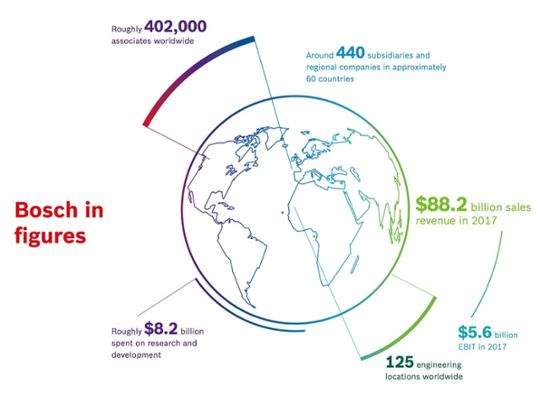
(Robert Bosch, 2018) As a leading IoT company, Bosch offers innovative solutions for smart homes, smart cities, networked mobility, and networking (Robert Bosch, 2018). It leverages its expertise in sensor technology, networked software and services as well as in its own IoT cloud, offering cross-domain solutions from a single source to its customers (Robert Bosch, 2018). The strategic goal of the Bosch Group is to deliver innovative solutions for a networked world. For this introducing and using Industry 4.0 in their plants and operations is a great example. Industry 4.0 is connecting technology assets and activities, through the exploitation of the opportunities of digitization, highlights the transparency of processes and integrates the corporate value chain and the supply network, bringing new value to customer value creation.
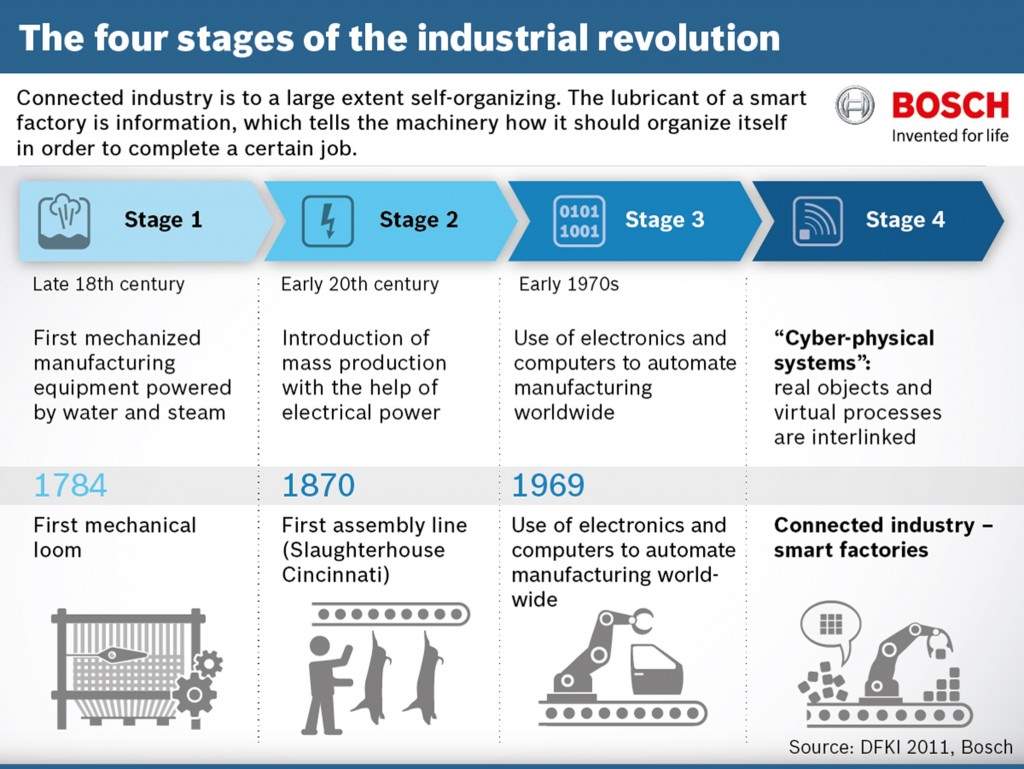
(Sahi, 2015)
3. Operations Management and LEAN
According to Operations Management (Slack, et al., 2016) Operation management is planning and organizing the production and service processes. The 10-operation management key decision areas are:
- Goods and services
- Quality Management
- Process and Capacity Design
- Location
- Layout Design and Strategy
- Human Resources and Job Design
- Supply Chain Management
- Inventory
- Scheduling
- Maintenance
These areas can be optimized and can be effective with the help of LEAN. Bosch was one of the first companies that recognized this, and they created Bosch Production System based on LEAN.
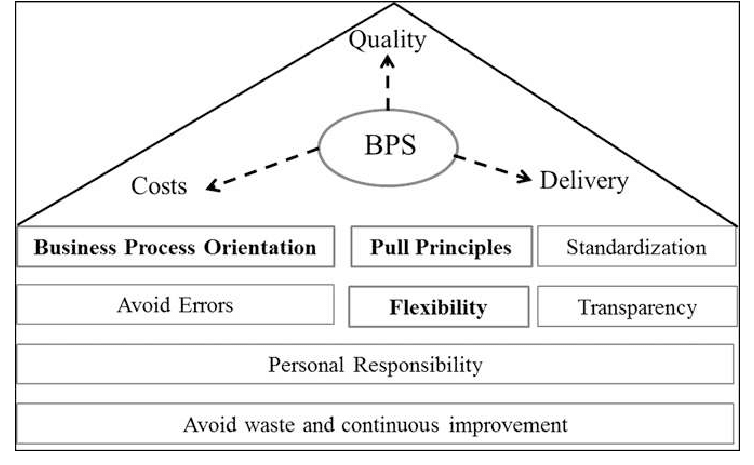
(Gnoni, 2013) The essence of Lean's philosophy is to reduce the lead time (Lead time: Time to prepare a product from raw materials to ready condition, after ordering up to delivery.) of the value creation process - and the inventories in production, the resources tied to the service- by effectively eliminating losses, so that the company respond more efficiently, faster and more flexibly to customers' needs (Liker, 2004). Thereby significantly increasing the company's competitiveness and the rate of capital flow within the company (Liker, 2004). The Lean philosophy has two main principles: the first is respect for man, the second is the minimization of losses. The latter can easily be interpreted as this means the exclusion of the losses from the processes as high as possible. But what is really the respect of people? In the case of Lean philosophers, employees are the company's highest value, so they are listened to and, if they find it useful, they use employee feedback and ideas to make production more efficient. This engagement and empowerment gives the worker the opportunity to get rid of troublesome products and process steps that will put an unnecessary burden on him, which also reduces stress.
Our academic experts are ready and waiting to assist with any writing project you may have. From simple essay plans, through to full dissertations, you can guarantee we have a service perfectly matched to your needs.
View our servicesIn addition, Lean management is a very big step forward from the break with the very narrow specialization, which enhances job enlargement and job enrichment. From these concepts it can be clearly seen that there is a difference between the two definitions, but this does not generally appear in the literature, except for Brunner (2008), who separates Lean eliminates and minimizes waste by increasing process efficiency and reducing losses. The main goal of the company is to maximize the value of customer value in our production or service process, and to keep the processes cleaned by the kaizen actions (continuous improvements) of the 7 main losses, which are (Liker, 2004) : 1. Overproduction (this is the most basic loss, because this is the root cause of all further losses); 2. Superfluous movements; 3. Waiting times; 4. Transports; 5. Over processing; 6. Stocks; 7. Faults. These seven major losses, (Liker, 2004): "The Toyota Method", complements an additional factor of 8, which is as follows: 8. The unlimited creativity of the staff: Time, ideas, skills, development and learning opportunities are lost and missed because we do not involve or listen to our colleagues. Based on my observations in Bosch factories, with a ninth very dangerous loss form can be identified: 9. Non-recognition of losses. The cause of this additional point will be specified in the Challenges section. So, with LEAN and Industry 4.0, Bosch aims to make history in the optimization in every aspect that a company has.
4. Logistics in SCM
Logistics is a part of Supply chain management (SCM). Supply chain management includes all activities related to the production and delivery of the product, from the supplier to the final consumer (Bowersox, et al., 2013). 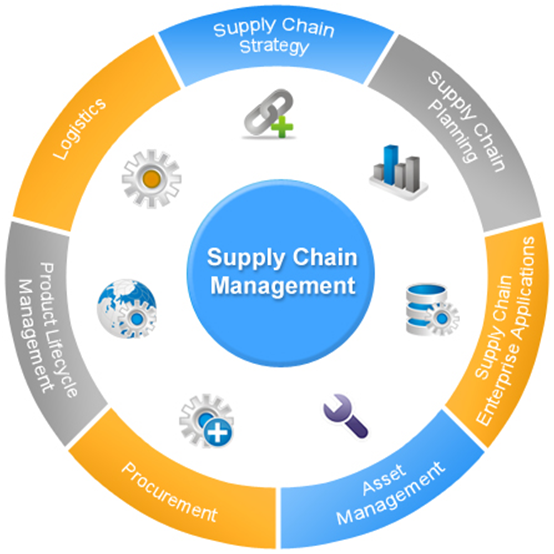
(GOYAL, 2018) Logistics is particularly important as it is essentially capable of influencing the company's business performance and customer satisfaction. In logistics and supply chain processes, in many places, inefficiencies and losses can arise, like late deliveries and rising fuel costs. The use of sensors in processes creates transparency and flexibility when data is transmitted via the Internet to the cloud and shared with the partners as this can ensure systemic optimization. By doing so, value-creating processes can be fully tracked in real-time, it is possible to handle exceptional cases, use mobile devices, create mobile human-machine platforms to create paper in workflows, and with the appropriate software development all data can be analyzed and used for process improvement If we look at the subsystems of the Bosch logistics system, we can find many applications. The warehouse can be seen in the company Info-Communication Technology and planning system to see the expected production needs as well as the orders for delivery. Based on these, own capacities and resources can be planned to prepare for receiving, storing, receiving, and serving your production. On the output side, again, the production plan is the basis for calculating the finished product stocks, warehouse locations and deliveries. Thus, logistic capacity planning can be realized at the same time as production planning, providing real-time data on a continuous basis.
Mechanization, automation, and robotization of logistics processes have evolved a lot in recent years. We are seeing more and more solutions to the cargo, but also about the picking process, in support of human work. Bosch solutions for these systems are leading the market because sensors can contribute to monitoring and improving the performance of working people. During warehousing and material handling, from the earlier real-time data, the Warehouse Management System will know exactly where, when and how arrival is expected from either suppliers or the product is finished. Most of the warehouse activities are robotized (loading and unloading), and the extended reality can be used in order-picking. Continuous communication with affiliates and external partners has a positive impact on all these processes. One of the critical points in logistics processes is the freight transport itself. Through the comprehensive design of the entire operating process, the production plan will clearly show how much transport capacity will be needed to deliver the manufactured product. Therefore Bosch uses Justin Time – JIT. According to Supply Chain Logistics Management (Bowersox, et al., 2013) JIT makes sure that: - the corresponding product; - in the appropriate quantity; - at the right time; is manufactured and moved. JIT aims to reduce the production lead time (Slack, et al., 2016).
To help JIT making as efficient as possible, sensors built into products and cargoes can track merchandise, transport conditions, facilitate identification of goods at loading and unloading, significantly reducing their time. With GPS, the vehicle could be tracked earlier, but it allows real-time overview of driving, driving habits, fuel consumption control. Systematic analysis of logistical and supply chain processes enables efficient management of the variability of capacity demand and fluctuation in costs (Bowersox, et al., 2013). These analyzes are indispensable in strategic purchasing decisions, planning of the distribution grid, and in the process of demand and inventory planning.
5. Design of Goods and Services
Bosch always considers close cooperation with customers, to offer many opportunities to provide, when it comes to design new or redesign old goods or services. As most innovation of design of good and services comes with Industry 4.0, Bosch needs to adapt to consumer needs. But is can be difficult as even the level of product clarity, the linked services can be divided into different levels: The service is based on the availability of the sensors in the product. This is also a part of the problem suite that there are no unified standards or software, so the customer may not read the data from the product but would like to do so. So, if this service is offered, then the first level is that the data or a data generator can be read by the buyer. Second level is, if the manufacturer offers the buyer a purchase or disposal of software for reading and analyzing the data (in the hope of long-term cooperation). The third level is the service that the customer receives already analyzed data via a computer or telephone application. One of the achievements of Industry 4.0 in Bosch, is that besides the product, the customer receives a serious digital service package.
In order to meet customer requirements as much as possible, the customer can use the services from the portfolio for which they are valued, but the higher the customer reaches for the service they are using, the more their dependence on the supplier may be. This dependence may arise from the fact that the supplier handles the buyer's data, analyzes them, and the buyer has to rely on it. Another way for digital services is to operate integration hubs from manufacturers, which can be a great value for the buyer.
6. Human Resources
Human Resources are responsible for taking individual and organizational goals into account. In another sense, providing human resources help to achieve the organization's defined goals, which are adequately trained, efficient and sufficiently motivated workers. (Torrington, et al., 2017) In Bosch factories and plants, man and machine interfaces with each other, connecting the physical and virtual. This kind of interconnection also creates new expectations for the workforce and the organization, regarding skills, work safety, data protection and flexible working time. Continuously changing technology also requires the development of employees' attitudes, Life Long Learning cannot be circumvented in this area. Firstly, Industry 4.0 creates new jobs that will be essential for analyzing huge amounts of data generated by machines and equipment, integrating them into corporate Communication Technology and Enterprise Resources Planning systems, producing them in the right complexity, and attain all management levels. The software developers, data miners, application developers, or even statisticians and controllers provide the key process to get information that can be used in decision-making. The success of the company depends to a large extent on its Digital IQ, what it will be able to extract from its available data and how it can be utilized (BISWAJEET, 2018). According HUMAN RESOURCE MANAGEMENT (BISWAJEET, 2018) lack of digital culture and training is the biggest challenge for companies.
Secondly, another important focus of the human resource theme is rather related to corporate culture. Industry 4.0 is aiming to eliminate low or mid-level, easily automated jobs, and it is currently happening. Many new jobs will be generated by machines, but in fact, more workforce will be required with just as much skill as now.
7. Challenges and Recommendations
When we look on the challenges, it is imperative for the company to assess its realistic potential, problems, external and internal factors. SWOT analysis is a great method for this, which results in a table that assists the evaluation. The SWOT analysis for Bosch:
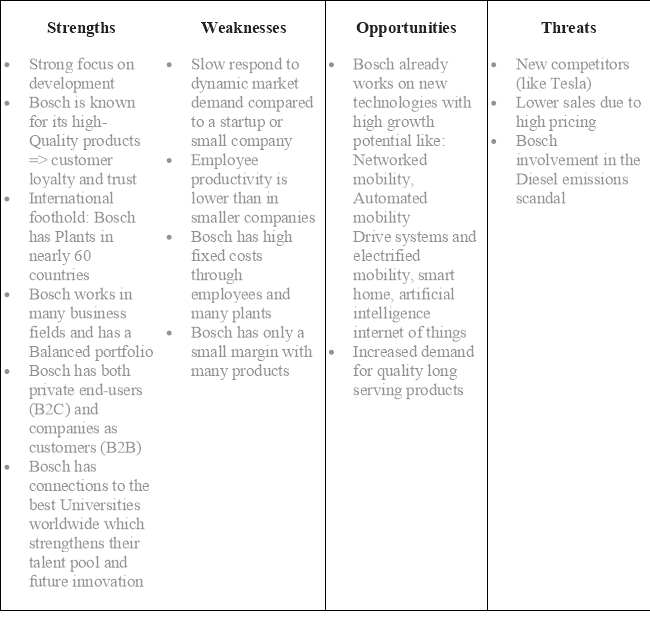
Adapted from garberson.org (Steinhilber, 2017)
The biggest obstacle affecting all operation areas are coming from the big size of Bosch, without clean and clear strategy in value-creating (production and logistics) processes and sufficient leadership support, it can lead to production failure and major losses for the company but can be solved with continues top down management support during company events, or trainings. As Bosch have a strong focus on development this problem can be handled correctly. Another big challenge is using these kinds of online and cloud-based services, as data security becomes a major a risk factor, especially when it comes to external data or data sources. But this can be managed with the correct planning and taking security seriously.
Furthermore, the labor force with inadequate qualifications is considered a barrier. Bosch invest a lot in training its employees, but as it is a huge company world-wide, it is not always easy. In my point of view the way to avoid is by creating a Training centers for every 2-3 country which are organizing, as currently Germany is the only Training center for all Bosch locations. Continuing with the possible problems coming from the size of Bosch, not adapting fast enough, and not realizing losses can lead to losing a lot of resources and money. As the same as for trainings, I think Bosch should create smaller Headquarters for every 3 country they are present. This would mainly help the adaptation of the changes in the regions, or world-wide, it would also help the operations management to develop faster. Last but not least, it is also important hindering factor for the spread of industry 4.0 standards and certificates are limited in other companies. The basic technological tools of digital infrastructure are slowly spreading, not necessarily available in every supplier or customer organization, so cooperation may be limited. This means spreading these tools and processes are necessary for more ideal usage.
8. Conclusion
In my point of view the future of Bosch is currently doing all operation areas the best they could to adapt to the market by improving continuously. Despite the fact, that they will surely be in the leading companies in every portfolio they present for the next 5 years, they need to make some changes in their structure to make operations management maintainable for the future.
9. References
- BISWAJEET, P., 2018. HUMAN RESOURCE MANAGEMENT. Fifth edition ed. Delhi: PHI Learning Pvt. Ltd.. Bowersox, D., Closs, D. & Cooper, M. B., 2013. Supply Chain Logistics Management. Fourth Edition ed. New York: McGraw-Hill International (UK) Ltd.
- Gnoni, M., 2013. Researchgate. [Online] Available at: https://www.researchgate.net/figure/Main-pillars-of-the-Bosch-Production-System-BPS_fig2_271582392 [Accessed 10 December 2018].
- GOYAL, A., 2018. octalsoftware. [Online] Available at: https://www.octalsoftware.com/blog/supply-chain-management-software [Accessed 10 December 2018].
- Liker, J. K., 2004. The Toyota Way: 14 Management Principles from the. Maidenhead: McGraw-Hill . Robert Bosch, 2018. Bosch.com. [Online] Available at: https://assets.bosch.com/media/global/bosch_group/our_figures/pdf/bosch-today-2018.pdf [Accessed 10 December 2018].
- Sahi, M., 2015. Tractica. [Online] Available at: https://www.tractica.com/automation-robotics/collaborative-robots-in-industry-4-0/ [Accessed 10 December 2018].
- Slack, N., Brandon-Jones, A. & Johnston, R., 2016. Pearson Education Limited. Eight edition ed. Harlow UK: Pearson Education Limited. Steinhilber, T., 2017. Garberson.org. [Online] Available at: http://www.garberson.org/2017/10/robert-bosch-gmbh-swot-analysis/ [Accessed 10 December 2018].
- Torrington, D., Hall, L. & Taylor, S., 2017. Human Resource Management. Tenth ed. Harlow: Pearson Education.
Cite This Work
To export a reference to this article please select a referencing stye below:
Related Services
View allDMCA / Removal Request
If you are the original writer of this assignment and no longer wish to have your work published on UKEssays.com then please:
 GBR
GBR 












